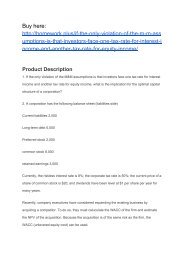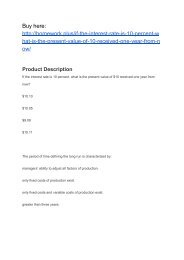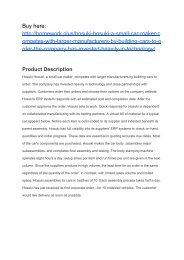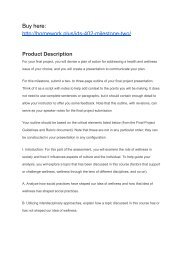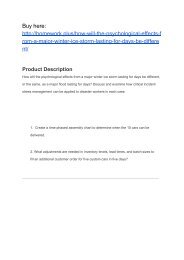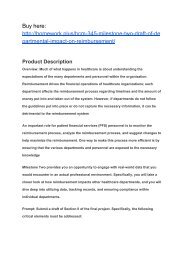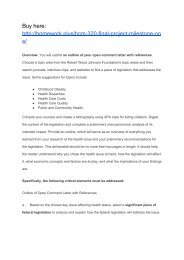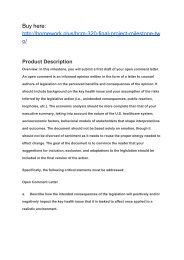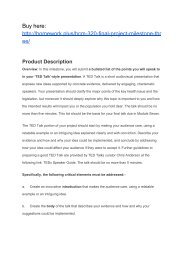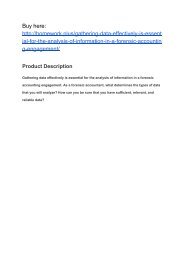FIN 665 Final Project
FIN 665 Final Project
FIN 665 Final Project
You also want an ePaper? Increase the reach of your titles
YUMPU automatically turns print PDFs into web optimized ePapers that Google loves.
Buy here:<br />
http://homework.plus/fin-<strong>665</strong>-final-project/<br />
Product Description<br />
The final project for this course is the creation of an Individual Case Analysis. The<br />
primary objective of this project is for students to understand how to analyze the<br />
capital structure of a company. Students will also improve their understanding of<br />
some basic forms of debt financing and learn to formulate strategies in structuring<br />
debt financing. The case will also expose students to the process of debt rating and<br />
its importance. Because of its international setting, the case provides an excellent<br />
opportunity for students to obtain an understanding of international capital markets<br />
and offshore offerings. Students will apply the case method described in this<br />
document. They will define the problem, build an analysis separating the important<br />
facts from the peripheral data, develop alternative courses of action citing advantages<br />
and disadvantages, and make final recommendations on policies that will maximize<br />
value for the business.<br />
Main Elements<br />
Case Method<br />
The case method is an important tool in educating managers by allowing students to<br />
bring to life conceptual material that is often difficult to understand without<br />
application, and aiding in integrating tools and theories students have learned by<br />
applying them to relevant management decisions.
The cases used in this course are a record of issues and problems actually faced by<br />
business executives, with supporting facts, opinions, and financial data that<br />
decisions were based on. These real-life situations are summarized by case writers<br />
who provide you with all of the relevant information that was available to the decision<br />
makers involved. If the information presented seems incomplete, remember that this<br />
only mirrors the business world reality of decision making with limited information.<br />
Obtaining more information costs time and money, resources that are scarce in most<br />
situations.<br />
Each case, like each management situation, is unique. Since there is no one best<br />
procedure for solving problems or making decisions, there are no right or wrong<br />
answers in case analysis. Each class member will approach the case in a different<br />
manner. However, the following procedure can serve as a rough guide to your<br />
analysis which can be fine-tuned to personal preferences.<br />
Procedure<br />
1. Read the Case. The first step is to get acquainted with the situation. Read<br />
through the case quickly, getting a general feel for what is going on. Who are the main<br />
players? What types of information are available to you? Go back and reread the case<br />
carefully, paying particular attention to case facts, figures, and diagrams. Be careful<br />
to separate symptoms and problems. Case writers will often flag important issues by<br />
italics, headings, or questions at the end of the case.<br />
2. Define the Problem. Put yourself in the place of the decision makers in the case<br />
(managers, investors, debt holders, banks, employees, etc.). What are the critical<br />
issues? Does one problem stand out as primary, with other problems secondary or
contingent upon it? Establish a time dimension to the problems; which problems<br />
demand immediate action, and which are long-term or strategic in nature? What<br />
critical assumptions are being made by the decision makers in the case, and how do<br />
these assumptions influence their chosen strategies? Try to state the problems so as<br />
to identify (a) who must take action, (b) why action must be taken, and (c) when<br />
should action be taken.<br />
3. Build your Analysis. Gather the important facts and concepts in the case, and<br />
discard unimportant or fringe issues and data. Build a theme for your analysis, and<br />
establish the importance of the problems you have identified. Incorporate your<br />
knowledge of cultural impact on the situation, financial analysis, accounting<br />
techniques, marketing methods, economics, and human behavior into your analysis.<br />
Put theory to work in your paper, by using concepts from the readings and module<br />
overviews to analyze the problems and issues and explain why they require<br />
responses by management.<br />
4. Develop Alternatives. Examine the alternative courses of action that are available<br />
to the firm. Make a list of the advantages and disadvantages of each. Don’t use<br />
“straw-man” alternatives (those that are patently unfeasible or undesirable). Develop<br />
a few well-reasoned responses that could solve the problems, and critically evaluate<br />
them.<br />
5. Make a Recommendation. Based on your analysis of alternative courses of<br />
action, choose the best and recommend course of action. Be specific in your<br />
statements. How will your recommendation be implemented? Circle back through the<br />
case to identify possible points of inconsistency between your recommendation and<br />
case facts. What potential problems might crop up? How will internal constituencies<br />
(e.g., management, employees) and external constituencies (e.g., competitors,
stockholders) react, and how will you handle their responses? What assumptions<br />
have you made in developing your recommendation?<br />
Please review Writing and Revising/ Editing the Case Analysis for additional<br />
information on structuring a case analysis.<br />
Deliverable: Case Write-Up<br />
The write-up must include the following items:<br />
●<br />
●<br />
●<br />
●<br />
Title page containing case name and date<br />
Brief summary of the business situation in the case<br />
Identification of problems or issues<br />
Analysis of the problems or issues including the nature of the problems,<br />
causes of the problems, constraints, and related theories (framework for<br />
your analysis)<br />
●<br />
List of alternatives for solving problems, including pros and cons of each<br />
alternative<br />
●<br />
●<br />
●<br />
Your recommended alternative and clear reasoning for you decision<br />
Supporting spreadsheets or charts<br />
References




